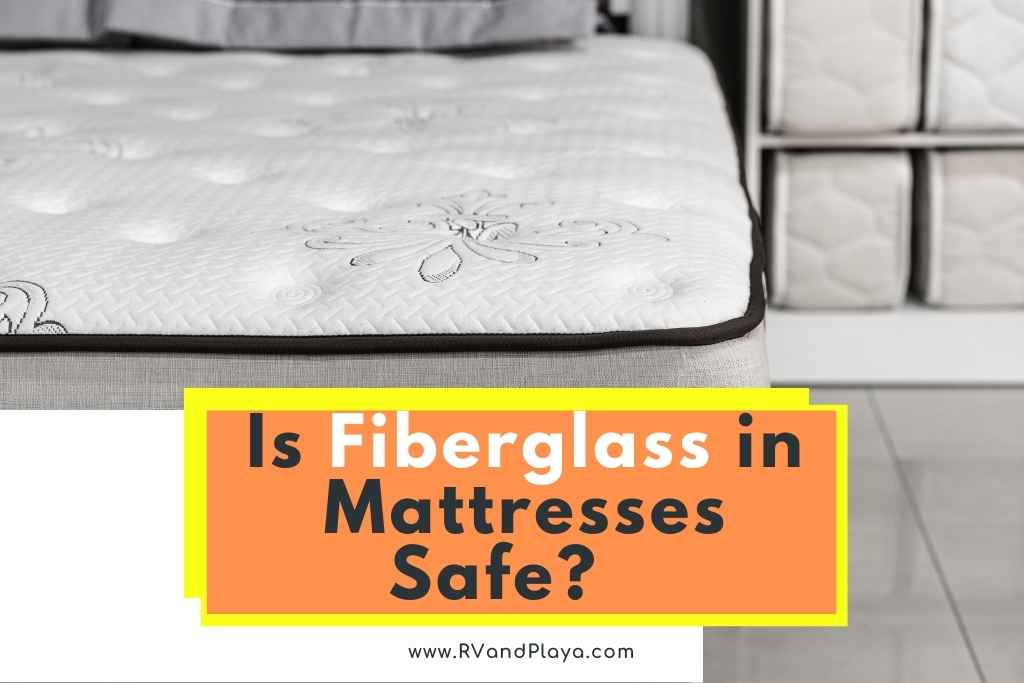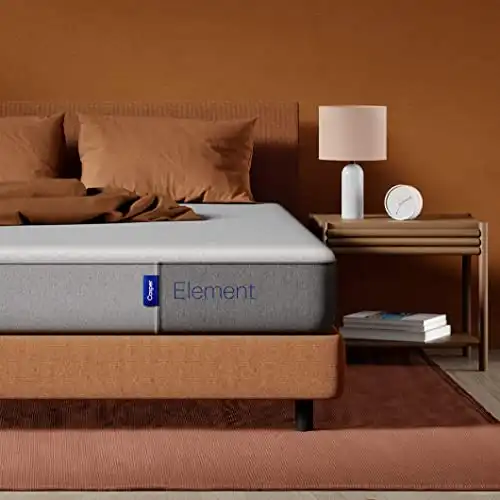Do you know if fiberglass in mattresses is safe? Well, you are at the perfect place to find the answer to such a question.
Fiberglass in mattresses is safe if you maintain the mattress properly and you research how the manufacturer uses it. Mattresses have fiberglass in them, but not always. There’s a lot of controversy surrounding this topic. Fiberglass is dangerous if inhaled or ingested. It also causes skin issues.
Shopping for mattresses on a tight budget is tough. Manufacturers use fiberglass in mattresses because it’s cheaper than many of the alternatives.
In this article, we’re exploring the dangers of fiberglass, how to avoid those dangers if you have a mattress containing it, and what you should or shouldn’t do with this kind of mattress.
Read on to find out everything you should know about mattresses with fiberglass.
Table of Contents
Why Is Fiberglass in Mattresses?
Fiberglass is a flame retardant. It’s used in mattresses to create a protective layer that won’t burst into flames in the event of a housefire.
There were a number of chemicals and other substances used in the past as fire retardants on mattresses. Many of them were deemed harmful, though. The other issue is the cost of many of the other options.
Fiberglass isn’t harmful enough for regulators to ban it for this use. It’s also far less expensive than other options, allowing for some mattress brands to be more affordable.
Read also >> Does Lucid Mattress Have Fiberglass? (Safe, Flame Retardant)
How Does Fiberglass Effect You?
Fiberglass is composed of tiny plastic fibers that are boded into tiny glass fibers. These little fibers are sharp and will stick in your skin like a thorn that you can’t even see it. If it finds its way down into your brachial tubes and lungs, it will cause sneezing, coughing, irritation in the airways, and will progressively worsen.
The worst part is that if it finds its way into the air, your air conditioning (HVAC) system will effectively disperse it throughout the entire house. A/C filters won’t come close to capturing everything.
You will think you are having an allergic reaction to something and, unless you see the fact that there is a tear in your mattress, you may not know the cause in the beginning.
When fiberglass comes into contact with your skin, it will cause itching and tiny lumps of irritated skin will rise up. Your initial reaction might be to suspect bed bugs or fleas as there are similarities in the symptoms.
If this ever happens to you, grab a roll of masking tape and wrap it or stick it to the exposed areas of skin that are irritable. Peel the tape off slowly and it will pull the tiny little fiberglass spines out of your skin.
How Is Fiberglass Used in Mattresses?
Some manufacturers put the fiberglass on the mattress. It’s woven into a sheet and is attached to as the top layer of the mattress core. Some companies may weave the fiberglass into the other materials throughout the entire mattress.
Finally, some companies position the fiberglass layer inside the mattress shell. That means the fiberglass layer sits inside the cover and on top of the mattress. This is the safest option. Keep reading to find out why a little further down.
Is Fiberglass Safe?
Fiberglass is essentially tiny little threads or shards of glass. That’s why if you’re working with fiberglass, you should always wear gloves to protect your skin from all those little shards. They can embed in your skin and cause all sorts of irritation.
Fiberglass is safe when it’s handled responsibly. The dangers of it come from improper use or handling. It shouldn’t come in contact with your skin.
You should wear eye protection if you’re working with it. You also don’t want to inhale or ingest it.
What Are the Dangers of Fiberglass?
Skin irritation and skin conditions are included in the dangers of fiberglass. The strands or shards of glass will poke your skin and get stuck there. They’re so tiny, you may not see them but you will feel them. They can cause itching, rashes, allergic reactions, and more.
There’s also the risk of inhaling fiberglass. When fiberglass is exposed to the air, it disperses throughout it. Once it’s in the air, there’s no way for you to know if you’re inhaling it. Your home’s HVAC system will suck it in through an intake vent and disperse it even further into every corner of the home. It’s nearly impossible to clear it out without professional help.
Inhaling fiberglass leads to respiratory issues. You may develop a bad and persistent cough. The fiberglass can make it into your lungs and cause scarring.
Anyone with asthma will likely experience an increase in incidents of needing an inhaler and more severe symptoms.
You could also swallow fiberglass shards. That can make your throat sore. As it reaches your stomach, you could feel nauseous.
Eventually, it will travel into your intestines and cause a lot of digestive discomfort and problems.
|
|
|
- 100 Night sleep trial
- Breathable foam
- Ecofriendly knit cover made from recyclable materials
- Made in USA
- Adaptive Foam Infused With Graphite And Memory Foam
- Green Guard Gold & Certi-PUR US Certified
- Made in USA
- 101 Night sleep trial
- Unbeatable lifetime warranty
- Thoughtfully designed foams in every layer
Can it Endanger Your Home?
It may be an extreme example, but a fiberglass mattress was responsible for running these people out of their homes. That’s not something that happens often, however, if the stuff really gets loose out of your mattress, it can spread around your home rapidly, especially if it gets in your HVAC system.
If you’ve ever worked with fiberglass before, especially in the insulation industry, you know just how irritating the substance can be and that’s before it makes its way into your lungs. It has the potential to endanger everyone in your home on a long-term basis, even if you get rid of the mattress immediately.
How Do I Stay Safe with a Fiberglass Mattress?
The section above might sound a little scary. But, if you already have a fiberglass mattress (check the label), or you’re going to get one because it’s within your budget, you can stay safe with a fiberglass mattress.
Here’s how:
- Leave the shell on – Fiberglass mattresses come with a shell, sleeve, or sock that they’re encased in. Some may even have a zipper. DO NOT take the shell off. Those shells are not meant to be taken off. That will allow the fiberglass shards to escape into the air.
- Your best option is the fiberglass layer on the inside of the cover – We mentioned above that the safest positioning of the fiberglass layer is on the inside of the cover. Some manufacturers aren’t as clear as others about how the fiberglass is used, so look for a mattress that’s labeled well.
- Put another cover over the mattress – Purchase a cover you can take off and wash to install over the mattress shell. It gives you another layer of protection and keeps some wear and tear off the mattress itself.
- Maintain your mattress – If you take care of your mattress, you shouldn’t have any issues with the fiberglass inside. Inspect the cover every so often to make sure there are no holes or tears. Promptly repair anything that’s needed.
Read also >>Does Nectar Mattress Have Fiberglass? (Safe, Best Non Toxic)
Why Do Mattresses Need Fire Retardant Layers?
Laws were passed in 2007 mandating the use of fire retardants in mattresses. Prior to that, mattresses were some of the most flammable pieces of furniture in homes.
The surface of a mattress is broad, too, making the spread of fire fast and easy on a bed.
All mattress manufacturers must use an approved fire retardant to protect purchasers should a fire occur in their homes when they’re asleep.
A fiberglass layer slows the progression of fire because it keeps the bed from going up in instant flames.
As fire gets closer to the bed, it encounters the mattress but the woven fiberglass layer sort of melts together rather than going up in flames.
How Can You Tell if There is Fiberglass in Your Mattress?
The best way to avoid fiberglass in a mattress is to shop for organic mattresses. The problem is, you will have to really do your homework to find something that is even labeled organic.
Since there is a notorious lack of labels, you’ll need to actively search on the internet to find an organic mattress, and Sleep Foundation is one of the mattress retailers out there that markets and sells organic mattresses.
Another way to tell is to check any and all labels associated with the mattress. Of course, we just told you that labels are notorious for neglecting that information, however, some labels do have the information on there, so it’s worth taking the time to check it over.
There are two, nearly guaranteeing factors that your mattress has fiberglass, especially if the label doesn’t provide you with that information. The first sign is if it is an inexpensive memory foam mattress.
Memory foam mattresses have become all the rage and those of us who are on a budget are jumping all over cheap memory foam mattresses without realizing that they are probably manufactured with a lot of fiberglasses.
If you purchased your mattress from China, that’s the second near guarantee that the mattress contains fiberglass. China manufactures mattresses with fiberglass because of its fire-retardant capability and because it is an exceptionally cheap material to use.
Until you find a new, non-fiberglass mattress, be sure to check yours thoroughly for any damage. Also, make sure that you keep your fitted sheets fitted properly, only taking them off to wash and dry. Don’t use the mattress until you have a new fitted sheet back on it. If your mattress is damaged, it’s essential to get rid of the thing as soon as possible.
Conclusion
Fiberglass in mattresses isn’t ideal, but it isn’t always dangerous, either. Fiberglass is a highly effective fire retardant. That’s a good benefit.
You need to care for your mattress appropriately, though, to minimize any risk of fiberglass dispersement.
Make sure you know what you’re getting. Check out the label. If you see anything that says glass in any form, it’s likely a fiberglass mattress. Treat the mattress as such and there isn’t a safety issue.
References
https://www.ewg.org/news-insights/news/2022/02/fiberglass-new-hidden-hazard-mattresses
Recent Posts
Twin Mattresses Size Guide. Do you know how thick is a twin mattress or what is the twin size bed dimensions? Well, you are at the perfect place to find the answer to such a question. Twin...
Does Casper Mattress Have Fiberglass? (Best Without Fiberglass)
Have you ever asked yourself or your friend if Casper mattresses have fiberglass and what are the best mattresses without fiberglass? Well, you are at the perfect place to find the answer to such a...




